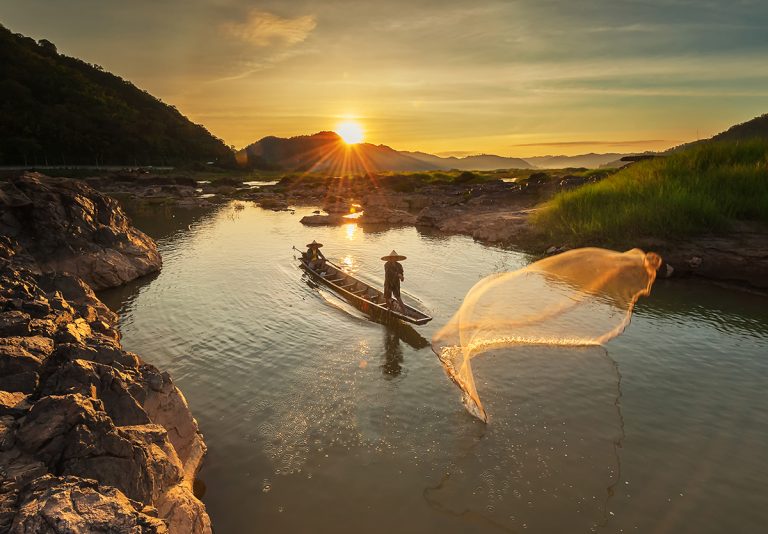Towards a greening of human rights: What does the right to a healthy environment mean for water resources?
 Fisherman (Photo by Suriya99, Shutterstock)
Fisherman (Photo by Suriya99, Shutterstock) The Earth’s water resources are critical to biodiversity and many ecosystem services, as well as to human life, health, dignity, and for food security. Water is most often the medium through which climate change effects are experienced, especially by the poorest in society. It is therefore imperative to include water governance within the wider remit of environmental governance, to ensure that groups and communities in vulnerable situations are protected. It is furthermore critical to integrate human rights within nature protection to achieve the transition that is necessary to get to net zero.
With this in mind, SIWI’s Swedish Water House arranged a webinar with Sida, the Swedish International Development Cooperation Agency, in January 2022, about the human right to a safe, clean, healthy, and sustainable environment (HRHE). The UN Human Rights Council’s adoption of Resolution 48/13 in October 2021 provides a partially new and important instrument in the toolbox for governance and environmental decision-making.
The HRHE clarifies the obligations of duty-bearing state governments, including the obligation to take preventive measures to protect nature and potentially vulnerable groups that are most at risk of harm. Some 150 states already acknowledge some type of claim to sustainable development and ‘good’ environment (such as in Sweden), through international agreements and/or in national legislation and policies.
The HRHE gives us a new context, with human rights at its core, enabling us to address freshwater resources degradation and overuse, as well as to restore ocean integrity and preserve marine life, now also with reference to a formally accepted human right. It takes a much wider approach than the established rights to safe drinking water and sanitation – acknowledged in 2010 – as it allows for consideration of all water resources. Wastewater, rainwater, soil moisture, fossile groundwater, the oceans, etc., are all included irrespective of whether they are useable for water services provision or not.
Though recently recognized as an autonomous right, it is not yet clear precisely what this ‘new’ right to a healthy environment means and how it affects the way we work with water resources and WASH. The HRHE differs from the rights to safe drinking water and sanitation (and other human rights) in that there are no distinct criteria or attributes that describe what it entitles to.
The modality is instead to draw on established human rights and obligations, as well as the environmental safeguards that exist in, for instance, global treaties such as the UN Convention on the Law of the Sea, and then apply them with a distinct rights-based approach. Dr David R. Boyd, the UN Special Rapporteur on human rights and the environment, clarified in his keynote presentation that more than 40 years of international law and regional experience with regards to regulating nature protection, have helped lay the foundations for the HRHE. Alongside the substantive rules and principles are procedural rights, such as on access to information and inclusive participation in public decision-making.
Panellist Annalisa Savaresi, an expert on the interplay between human rights and environmental law, added that although this right is not, technically, legally binding, it has the potential to become a game-changer as it is universally applicable, not only by those states that have already recognized similar obligations. Moreover, in the multiple environmental crises of the Anthropocene, the right serves as an additional tool. It can embolden NGOs, civil society groups and individuals to invoke litigation claims and demands on decision-makers, to request better laws and to ensure the enforcement of existing legislation. We will likely see both judicial and non-judicial complaints based on this right reaching the courts in the near future. These complaints may also happen in countries that do not yet acknowledge the right as a domino effect, similar to what has already been seen in the field of climate litigation. This could really help to bridge the accountability and enforcement gaps, which plague environmental and water governance.
Another expert in the panel of five who brought different perspectives was Claudia Ituarte-Lima, Senior Researcher at Raoul Wallenberg Institute of Human Rights and Humanitarian Law. Claudia suggested that the HRHE can contribute to achieve societal transformations for safeguarding biodiversity and healthy ecosystems, if we advance intergenerational justice and gender equalities in its implementation. Women, children and youth, indigenous peoples, and local communities in the global South are far from passive victims of environmental degradation. Many court cases, for example, build on these groups using their procedural rights as active agents of change. There are examples of biodiversity litigations where courts rule in favour of nature contributions to present and future generations, as well as nature’s intrinsic values. The HRHE can draw on such inclusive legal interpretations combining bottom–up progressive interpretations together with how the UN Human Rights Council and the General Assembly elaborate the HRHE definition.
With a human right that encompasses water in all its forms and for a large variety of uses, it is relevant to consider how land-based activities upstream affect humans, nature and the ecosystem all the way to the oceans, where pollutants end up. Taking a systems perspective, David Langlet, a professor of environmental law and ocean governance law, said that as inland waters, coasts, green areas, and oceans are physically connected, the land–sea divide needs to be bridged in policy and planning. This new right can be something to agree on across this divide, but its scope doesn’t cover issues relating to synergies and trade-offs between different kinds of rights, for instance in relation to biodiversity. Likewise, principles of legal standing and remedies within domestic systems, alongside activities through diplomatic means, may be more important where extraterritorial impacts are experienced, by individuals in another country downstream.
With regards to water resources Amanda Loeffen, Chief Executive Officer at Human Right 2 Water, reminded that the HRHE seeks to take a holistic view of the environment as a whole; developing dedicated attributes relating only to water would not do this broader human right justice. Loeffen continued that the General Comment No. 15 on the right to water offers authoritative guidance, including on resources depletion and protection of water from contamination, but highlighted that the environmental perspective has almost been forgotten in the contemporary focus on access to water for human needs. Boyd’s 2021 report on human rights and the global water crisis describes safe and sufficient water as one of the substantive components of the HRHE, and good practices have been identified to help reduce or prevent water pollution, alleviate water scarcity, reduce risks associated with water-related disasters, and protect or restore aquatic ecosystems.
This rights conversation is per definition human-centred, but the HRHE has the potential to reduce conflict of interests between the realization of the right to healthy environment, on the one hand, and protection of biodiversity on the other, for instance through nature reserves and conservation areas that apply a human rights-based approach (HRBA). Ituarte-Lima gave an example of a water tower project in Kenya that led to the displacement of indigenous peoples and violent conflict, when they were not allowed to carry out traditional practices and use their local, natural resources. Mainstreaming the HRBA has notably increased over the decades, since the UN Convention on Biological Diversity was drafted in the early 1990s, but it is imperative that the Post-2020 Global Biodiversity Framework, to be adopted this year, be guided by the HRBA, so as to benefit both people and nature.
The business community also plays a role in the context of the HRHE, and expectations are constantly growing on the private sector to respect human rights. This is laid down in the UN Guiding Principles on Business and Human Rights, which IKEA has endorsed. IKEA’s ‘water positive’ strategy helps support a healthy environment by increasing water availability and improving its quality in its operations and interlinked value chain. IKEA’s representative, Christina Niemelä Ström, emphasised that a systemic approach requires collaboration with others through multistakeholder platforms. The company’s engagement in the Science Based Targets Network is expected to help level the playing field in the textile industry in particular, which is the sector with the biggest impact on water resources. But the industry needs to continue to learn – from NGOs and other partners – and to continuously assess and revise some of their processes, for instance to increase (ground)water efficiency, and linking cotton production to biodiversity and farmers’ livelihoods. Going beyond the water and sanitation human rights, there are many more aspects to consider more systematically for due diligence.
The panellists agreed on the importance of the now formally adopted HRHE, but also on the need to go from conceptually agreeing on the right, to making it matter in practice. To become a catalyst for change, the realization of the right to a healthy environment requires that treaty rules and domestic law and policy are implemented in a more effective, systematic, and ambitious way than we see today. Encouragingly though countries are already seeking advice on interpretations and steps to be taken. A follow-up event later in the year will discuss what is being done to implement the right – again from a water perspective – through action at various levels.
This webinar is the first in a series; exploring how to advance the application of a Human Rights-Based Approach that safeguards all water-related human rights and ensures that no one is left behind.
Agenda
Welcome and introduction
- SIWI and Sida
Keynote speaker
- David R. Boyd, UN Special Rapporteur on human rights and the environment and Associate professor of law, policy, and sustainability at the University of British Columbia
Panelists
- Claudia Ituarte-Lima, Senior Researcher, Raoul Wallenberg Institute
- Amanda Loeffen, Chief Executive Officer, Human Right 2 Water
- Annalisa Savaresi, Associate Professor, University of Eastern Finland
- David Langlet, Professor of Environmental Law, Uppsala University
- Christina Niemelä Ström, Head of Sustainability, IKEA Supply
Moderator
- Jenny Grönwall, Advisor Water Policy & Rights, Stockholm International Water Institute (SIWI)
Keynote speaker and panelists
David R. Boyd is the UN Special Rapporteur on human rights and the environment and an associate professor of law, policy, and sustainability at the University of British Columbia, jointly appointed at the Institute for Resources, Environment and Sustainability and the School of Public Policy and Global Affairs.
Claudia Ituarte-Lima is currently Senior Researcher at the Raoul Wallenberg Institute and is also affiliated with Stockholm University and the University of British Columbia. For the past 20 years, she has specialized in human rights, biodiversity, and climate law.
Annalisa Savaresi is an associate professor at the University of Eastern Finland and director for Europe at the Global Network for Human Rights and the Environment. She is a renowned expert in environmental law and on the interplay between human rights and environmental law.
David Langlet is a professor of environmental law at Uppsala University. His research, which is often conducted in multidisciplinary collaborations, has touched on a wide range of topics in the fields of environmental law, law of the sea, energy law, and international trade law.
Amanda Loeffen is CEO of Human Right 2 Water and is an experienced general manager and business development executive in water, energy, and sustainable development. Her goal is to provide sustainable solutions based on human rights to improve water governance worldwide.
Christina Niemelä Ström is responsible for IKEA Supply sustainability agenda. She is an internationally experienced business leader with a deep understanding of the total IKEA value chain within Supply, Range and Franchise for over 20 years.
Read more about the topic
Organised by the Swedish Water House in partnership with


